Flounder fishing in Florida is a unique experience. These aren’t the typical fish that anglers usually catch. I can say for myself, I have only ever seen one person unexpectedly catch a Flounder in all the years I’ve been fishing. But that just means I haven’t looked in the right places or used the right techniques!

If you’re interested in Flounder fishing in Florida – and you should be – keep reading. Whether for fun or to bring them home to whip up some tasty recipes, learn all about how to get your fill of these interesting creatures…
Where to Find Flounder in Florida
Flounder prefer to stay close to shore. Therefore, you won’t be needing to go far to locate some. It can be tricky to find them but knowing their key habitats can help.

To start, you can find Flounder all along the coast of Florida. However, the Gulf of Mexico and the Northern Florida coast may give greater chances at locating more quantities. In these regions, Flounder will stick around hard, rocky, sandy, or muddy bottoms. You can also find them in shallower areas like inlets, tidal creeks, and grass flats, as well as around oyster beds, docks, piers, and maybe some nearshore wrecks.
Typically, Flounder eat small fish. So, if you find an area with lively smaller bait fish, there’s a good chance that Flounder are close by. They may be below the surface, hanging along the bottom, waiting to strike on unexpecting bait.
When to Go Flounder Fishing in Florida
Flounder fishing in Florida can be successful year-round. However, fall is probably the best time of the year as these fish prefer cooler temperatures. During this period, they stock up on food in preparation for winter and are, therefore, more open to eating. So if you come across some hungry Flounder in the fall, you should have no problem getting a bite or two!
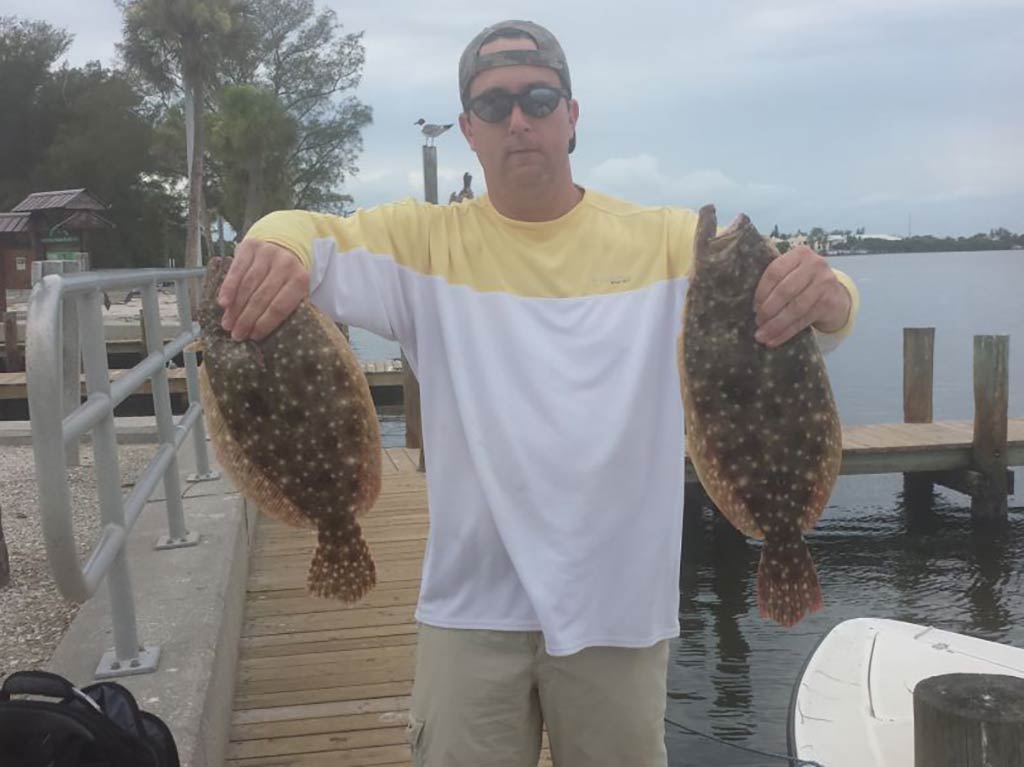
Something to keep an eye on when it comes to Flounder fishing in Florida is the tide. As mentioned, Flounder will hang around the bottom, where they’ll camouflage and hide from their prey. Once the prey comes close by, they’ll attack and enjoy a tasty treat. The best chance for bait to come near them is when the tide is pushing the current through. This will bring the Flounder closer in as the bait will be more active. Therefore, stick to any outgoing or incoming tides that have slight currents going on.
Flounder also travel with the tide, so you may want to change your spot depending on the conditions. For example, during an incoming high tide, look around inshore areas like inlets, piers, docks, and oyster beds. This is when the fish will come closer to locate additional shelter while looking for extra food opportunities.
If it’s a low outgoing tide, they may flock towards the deeper waters in order to not be so exposed. You can still check out some inlets and piers if they get you to the deeper parts. And flats that aren’t too exposed may be worthy of trying out too. The nearshore wrecks may also be good to inspect.
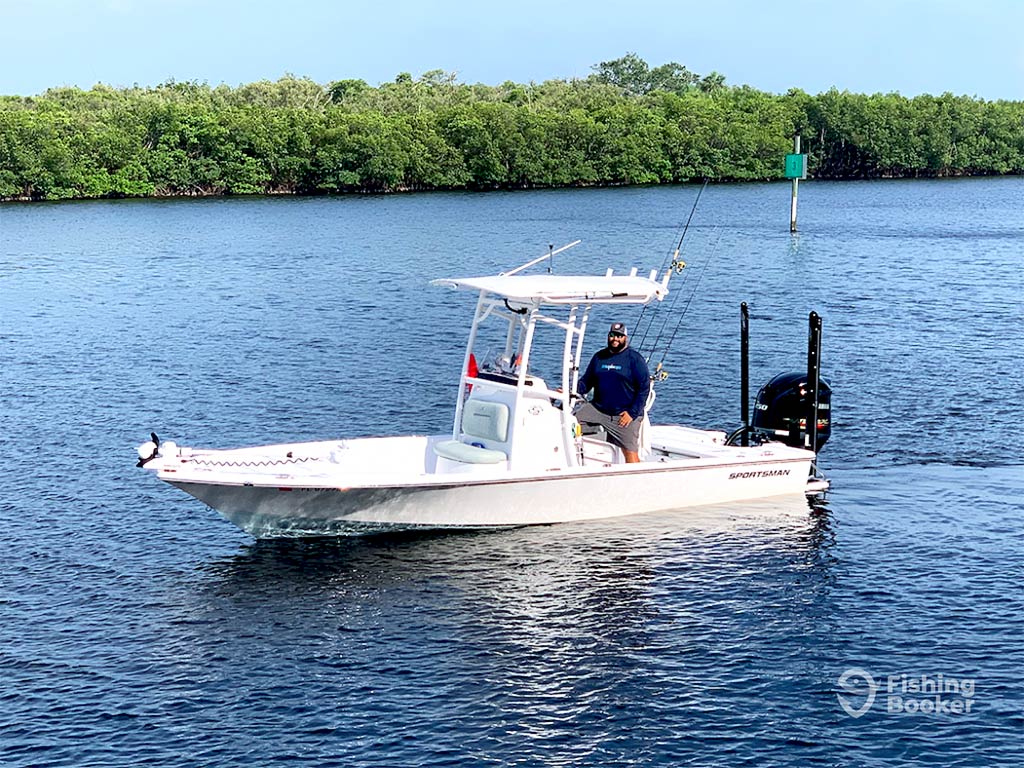
If you have to make a choice between high or low tide, many will say go for high tide. That will most likely bring you the best opportunity of coming across a variety of Flounder that made their way inshore on the prowl for food.
Another thing to consider is what time of day may provide the most success. Typically, if Flounder are hungry, they bite just about any time of the day. But since they prefer cooler conditions, if you’re able to get a high tide early in the morning or evening when the sun isn’t glaring down on the water, good results are almost guaranteed.
How to Catch Flounder in Florida
Flounder generally like to hunt and roam around in groups. Therefore, if you happen to see one, there’s a good chance there are more in the area. It would be beneficial to continue fishing an area if you catch one, as other little guys are probably hanging around as well. As mentioned, Flounder often dig themselves into the sandy bottoms a bit, so groups of Flounder may be in the surrounding sand. And this can apply to any area they may be in.

Stick around areas with flowing currents, as you should have good chances at finding some Flounder there. Ensuring you have the right bait to toss is also a bonus. They eat a mix of small pinfish, mullet, minnows, croakers, grunts, shrimp, and really any small live fish. Throwing down your bait with a sinker to keep it towards the bottom will allow it to drift towards the Flounder. That’s when they’ll get ready to strike.
Some anglers also enjoy the use of artificial lures to entice Flounder to bite. Your “non-live” baits will work best if you give them some slight jerks along the bottom, allowing them to mimic that of a lively fish. A couple of artificial examples that are successful for Flounder include soft plastic paddle or shad tails with ¼ oz jig heads, twitch baits, and Gulp shrimps.
My own fishing crew swears by the latter! We’ve caught many species on this bait, so it is definitely a recommendation of ours. While we haven’t tried it on Flounder ourselves, it seems quite a few people out there have made it happen. So, if you’re planning on going Flounder fishing in Florida, I suggest giving it a try. And let me know how you get on!
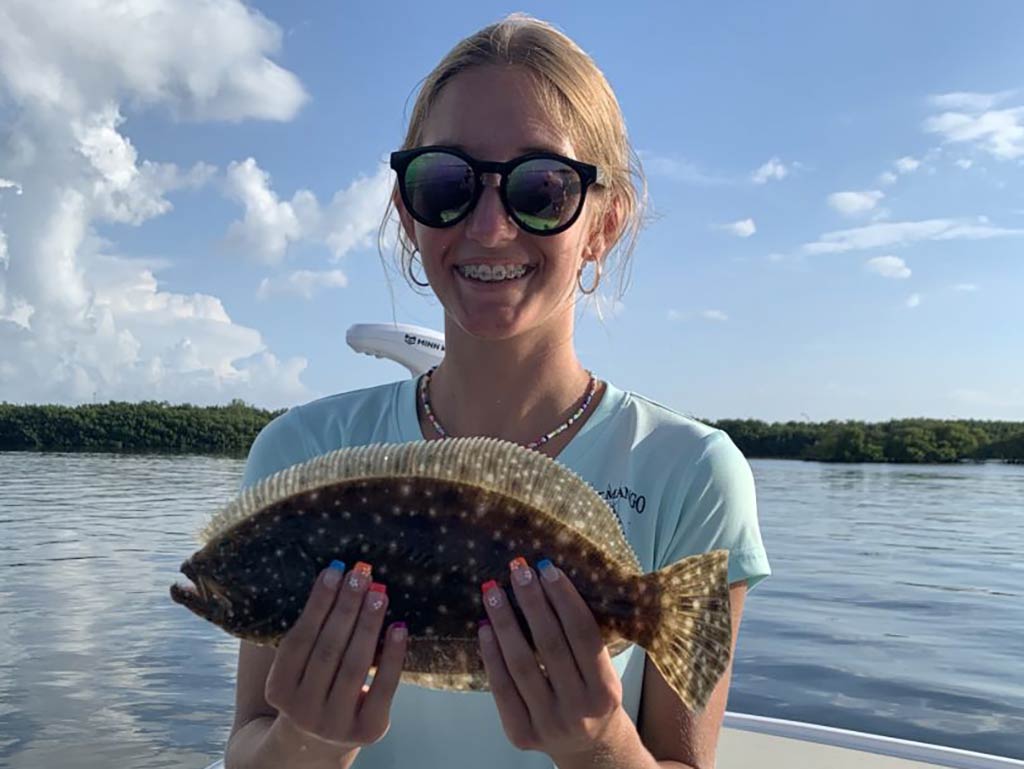
There’s no need for any heavy-duty fishing gear as Flounder aren’t particularly strong and don’t weigh much. You can use any set-up you have really. But if you want a more intense fight, go for a smaller set-up. You can use a medium-light rod paired with a 2000 reel to make the fight more interesting and to feel more forceful.
Flounder are aggressive eaters, and they’ll hit your bait hard when taking a bite. Once you feel the hard thump, it’s best to let it sit for a few seconds before you hook into them well. Once you feel you’ve hooked them well or believe the fish has swallowed the bait, you can then reel them in. But carefully! Flounder are like Tarpon, in the sense that they have tough mouths which can make it difficult to get a good hookset. Keep your line tight and avoid any tension as it can be easy for the hook to pull.
Another concern to keep in mind… Flounder are famous for shaking hooks, especially when you get them close to the boat. Just keep your line in, avoiding any slack. Once you get them to the boat, go easy. It’s a great idea to use a net to scoop them up easily and get them in before they have the chance to shake off.
Florida Flounder Fishing Regulations
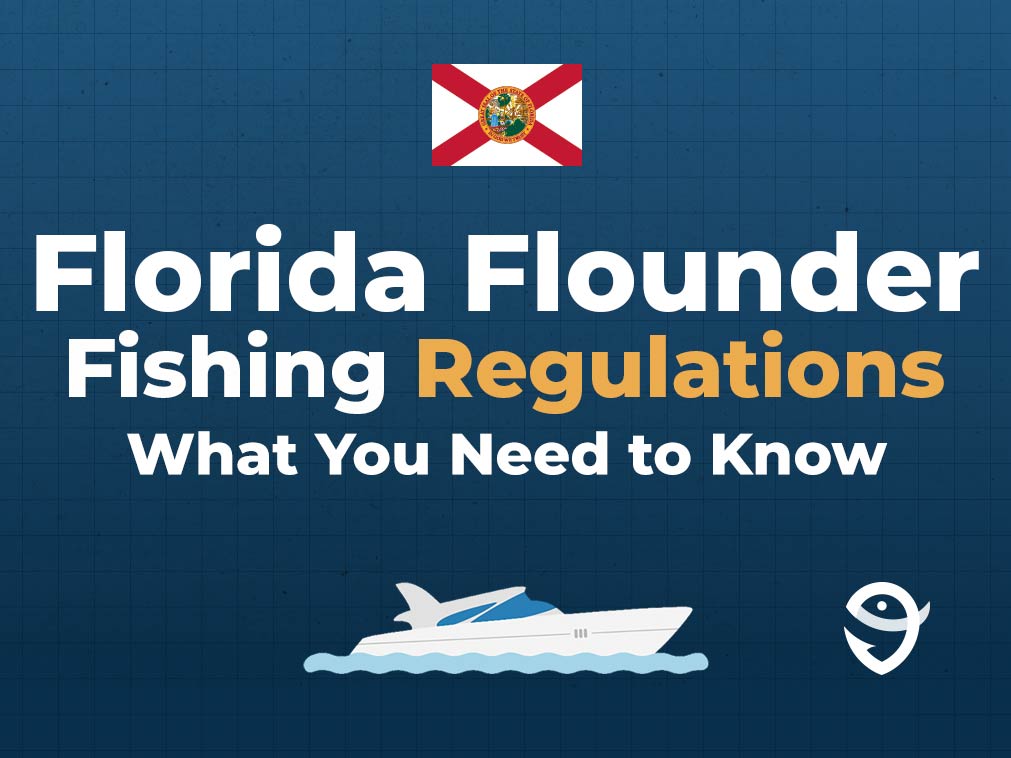
Flounder is a sworn-by, delicious piece of meat by many anglers and cooks. There are tons of recipes out there shared by lots of individuals that are loved by many. This is another reason why Flounder may be so sought after. If you’re on the hunt for a mouthwatering seafood meal to cook up, well you’re in luck – Flounder are allowed to be harvested! There are a couple of things to keep in mind, though…
First, Flounder season is not open year-round. For the most part, you should be able to harvest them, but there is an annual closure from October 15 to November 30. This is around their spawning season and peak, therefore harvesting will be closed to allow them to reproduce. It’s not for very long though, so you’ll be sure to take home some perfect filets in no time.
In addition to those regulations, your Flounder must be a minimum of 14 inches to harvest. To add, the daily bag limit is five Flounder per person, so you are able to gather a good amount as well. If you are planning on harvesting, take only what you need and let the rest go. This way, they can grow bigger and stronger and, in the future, can help populate the species further. This keeps the fishery strong and booming, which in turn can feed more bellies in the upcoming periods.
The last thing to add when it comes to regulations for Flounder fishing in Florida, is the allowed gear to use. The only legal gear permitted by the Florida Fish and Wildlife Conservation (FWC) is hook and line, cast net, spears, seine, and gigs. You are not allowed to participate in snatching, and you may not use multiple baits on a hook together (one live, one dead, etc.). As long as you follow all the regulations instructed by the FWC then you should have no issues harvesting your Flounder in Florida.
Flounder Fishing in Florida: All-Round Fun
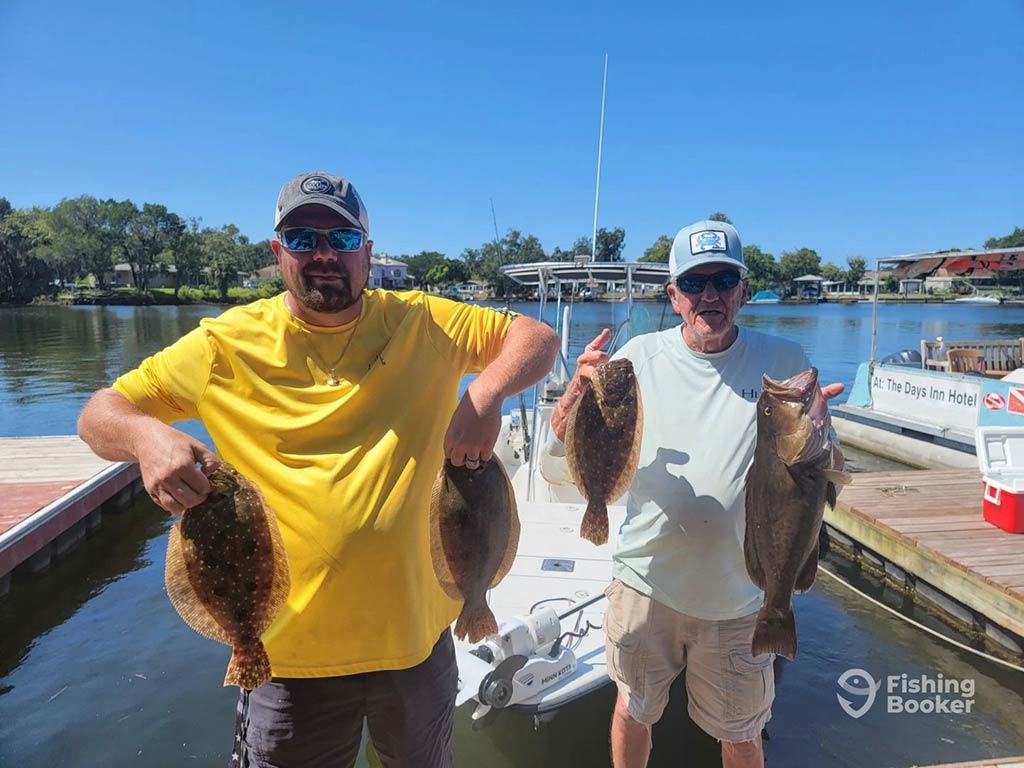
So, there you have it – the rundown on Flounder Fishing in Florida. Flounder is a cool species as you can catch it, keep it, and make some delicious meals from it! Many individuals state that Flounder is their favorite fish to catch because of their hard hits and risky fights. So get ready to work hard to get them in quickly before the possibility of losing them at the boat.
If you’re interested in Flounder fishing in Florida but aren’t sure where to get started, take a look at some of the charters included on Fishing Booker and see what guides close to your home or destination have to offer. And well, if you have your own boat or have access to decent saltwater spots on land, what are you waiting for? Get out there and find yourself a Flounder!
Have you ever been Flounder fishing in Florida? What was your experience like? We’d love to hear from you in the comments below!
The post How to Go Flounder Fishing in Florida: An Angler’s Guide appeared first on FishingBooker Blog.
https://ift.tt/oMZuF5w
0 Comments
Enregistrer un commentaire